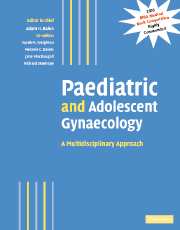Book contents
- Frontmatter
- Contents
- Contributors
- Preface
- Part I Normal development
- Part II Management of developmental abnormalities of the genital tract
- Part III Management of specific disorders
- 18 Disorders of growth and puberty
- 19 Turner's syndrome
- 20 Androgen insensitivity syndromes
- 21 Rokitansky syndrome and other Müllerian anomalies
- 22 The XY female
- 23 The gynaecology of the major genitourinary anomalies
- 24 Congenital adrenal hyperplasia
- 25 Long-term sequelae of genital surgery
- 26 Amenorrhoea
- 27 The polycystic ovary syndrome and adolescent women
- 28 Menstrual disorders in adolescent girls
- 29 Pelvic pain, ovarian cysts and endometriosis in adolescent girls
- 30 Premature ovarian failure and ovarian ageing
- 31 Gynaecological cancers in childhood
- 32 Late reproductive sequelae of treatment for childhood cancer
- 33 Preservation of fertility before cancer therapy
- 34 The management of infertility with surrogacy and egg donation
- 35 Dermatological conditions of the female genitalia
- 36 Vaginal discharge
- 37 Psychological gender development in individuals born with ambiguous genitalia
- 38 Eating disorders in adolescence
- 39 Nutritional amenorrhoea: long-term sequelae
- 40 How to set up a service: how to teach and train
- Index
- Plate section
- References
30 - Premature ovarian failure and ovarian ageing
from Part III - Management of specific disorders
Published online by Cambridge University Press: 04 May 2010
- Frontmatter
- Contents
- Contributors
- Preface
- Part I Normal development
- Part II Management of developmental abnormalities of the genital tract
- Part III Management of specific disorders
- 18 Disorders of growth and puberty
- 19 Turner's syndrome
- 20 Androgen insensitivity syndromes
- 21 Rokitansky syndrome and other Müllerian anomalies
- 22 The XY female
- 23 The gynaecology of the major genitourinary anomalies
- 24 Congenital adrenal hyperplasia
- 25 Long-term sequelae of genital surgery
- 26 Amenorrhoea
- 27 The polycystic ovary syndrome and adolescent women
- 28 Menstrual disorders in adolescent girls
- 29 Pelvic pain, ovarian cysts and endometriosis in adolescent girls
- 30 Premature ovarian failure and ovarian ageing
- 31 Gynaecological cancers in childhood
- 32 Late reproductive sequelae of treatment for childhood cancer
- 33 Preservation of fertility before cancer therapy
- 34 The management of infertility with surrogacy and egg donation
- 35 Dermatological conditions of the female genitalia
- 36 Vaginal discharge
- 37 Psychological gender development in individuals born with ambiguous genitalia
- 38 Eating disorders in adolescence
- 39 Nutritional amenorrhoea: long-term sequelae
- 40 How to set up a service: how to teach and train
- Index
- Plate section
- References
Summary
Introduction
The ovary is a particularly unusual organ in that it is programmed to expire long before the average age of death. As such, it provides a unique model of the ageing process. An ovary that fails prematurely might do so through some defect in its development or through accelerated ageing. Because it is difficult to distinguish between these possibilities, it is convenient to consider processes of dysgenesis and demise together. Various labels have been applied to the phenomenon of early failure of the ovary: ovarian dysgenesis is usually applied to those women who present with primary amenorrhoea; premature ovarian failure (POF) applies to those with secondary hypergonadotrophic amenorrhoea before the age of 40; and early ovarian failure applies to those who enter the menopause between the ages of 40 and 45. Resistant ovary syndrome and occult ovarian failure are hypergonadotrophic states without amenorrhoea but are usually considered to be part of this spectrum of disorders. POF has a prevalence of 1% and is defined as amenorrhoea of greater than six months' duration in the presence of raised gonadotrophins, follicle-stimulating hormone (FSH) greater than 40 IU/l, on at least two occasions and occurring before the age of 40 (Coulam et al., 1986). This contrasts with the mean age of menopause at 51 years (McKinlay et al., 1972).
Aetiology
The cause of POF in most instances is unclear; however two broad mechanisms can be considered, acquired or genetic aetiologies.
- Type
- Chapter
- Information
- Paediatric and Adolescent GynaecologyA Multidisciplinary Approach, pp. 373 - 388Publisher: Cambridge University PressPrint publication year: 2004



